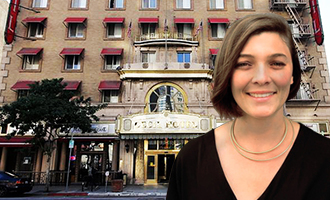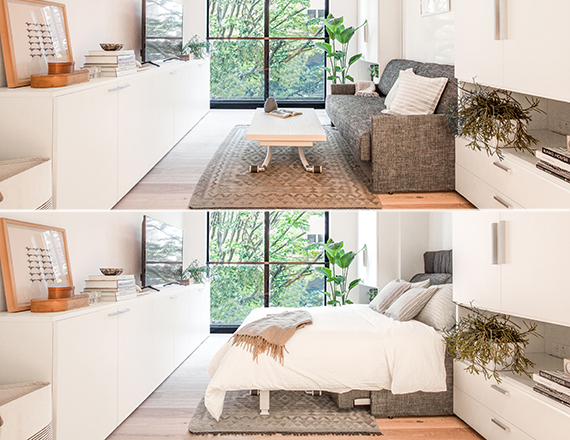New York-based co-living company Ollie will soon open its first West Coast outpost at the site of the former Hotel Cecil in Downtown Los Angeles. Simon Baron Development is converting the property to 301 microunits — which Ollie will then outfit with beds that turn into couches and amenities that include butler service.
The Skid Row-adjacent property at 640 South Main Street is known for a series of creepy events that took place there. In 2013, a young girl was found dead inside a rooftop water tank, and in the 1980s and 1990s, serial killers Richard Ramirez and Jack Unterweger were reported long-term guests.
But Ollie, as co-living operator, has lofty goals for the site and is unconcerned with its past, Ollie’s West Coast director Ellen Parry told The Real Deal. It wants to shatter cliches about co-living by appealing to a demographic beyond “Urban Outfitter’s vibe that only appeals to 23-year-olds,” she said.
“Millennialism is a lifestyle,” she said, adding that it will be on full display in the Hotel Cecil projects’ 30,000 square feet of communal space. “It’s the ethos of minimalism, the ethos of a curated lifestyle.”
Parry, who joined the company from multifamily developer Mack Urban, sat down with TRD to chat about Ollie’s future expansion, exactly how “millennialism” is a state of mind and why the company isn’t worried at all about Hotel Cecil being a haunted bus tour destination.
Who will be managing the day to day operations at Hotel Cecil?
Our first line of defense is our community manager. It’s going to be their full time job to put on community events and our first core concept is through food. Our amenities include food programming — having a barista, taco tuesday, wine wednesday, etc. This will be deployed in Hotel Cecil and at our seven projects across the country.
How does Ollie plan on mitigating Hotel Cecil’s reputation as a sinister spot, based on its history?
It’s something that we’re not concerned with. We’re not worried about the reputation. Haunted history can totally play into branding and positioning, but in my role, I’m not really focused on the Hotel Cecil. I’m focused on bringing new business.
What about Cecil’s proximity to Skid Row?
DTLA is experiencing a really robust live-work-play renaissance. There are all kinds of residential buildings all up and down Main Street and Broadway. Skid Row is certainly not getting in the way of residential projects in the Historic Core. I think [homelessness] is a separate issue. I would say that the Historic Core, where the Hotel Cecil is, is a vibrant residential community and that community is already well-aware of its circumstances and the people that live on Skid Row. There’s a lot of outreach to address the problems on Skid Row but it doesn’t detract from the Historic Core neighborhood.
How do you pick new locations?
We look for buildings clustered around employment centers. They must be transit-oriented in live-work-play [neighborhoods]. The other thing is size. We need 50,000 to 150,000 square feet in order to operate our platform, especially with our housekeeping and butler services.
Do you have plans of expansion in L.A.?
Yes. Within L.A., neighborhoods we’re interested in are the Arts District, Koreatown, Hollywood, Santa Monica and DTLA. We might open a second Downtown location beyond the Historic Core.
How are your projects financed?
We are an asset-light model. We partner with multifamily developers and take on two structures. The first is a master lease: We’d agree on what portion of the building we’re taking, so in a medium-sized building we might take the entire floor plate and we’d agree on the benchmark rent that they’d have earned at market rate. The second is third-party management, under which we provide technical design assistance, marketing and leasing, and other operational things. We layer alongside the developer in a revenue split of the upside. For Cecil, we are the operator.
How does your work with co-living compare to your previous job in multifamily development?
Ollie bridges the gap between traditional multifamily and hospitality. So [with Ollie], I get to bring in elements of hospitality service into the residential environment and also use programming to build community. In the traditional multifamily setting, tenants might not even know their next door neighbor, and you feel that amenities are too underused. People say in the lounges, for instance, there’s this sea of chairs that no one ever sits on. So, Ollie is focused on activating features like this.
How do L.A. and New York differ when it comes to co-living?
We always create unique local environments so we don’t have a set of design guidelines. Ollie in L.A. and Ollie in New York will look different but also have similarities. In terms of market differences, the value of roommates is a lot more appealing in L.A. than in New York, I think. West Coast culture is very much about what you do at home, whereas New York, people are always going out.
How do you put tenants together?
We use a software program called BedVetter, a roommate matching platform. When you sign up for Ollie, you log into this platform and answer a series of questions like what time you wake up or what kind of music you like. It’ll recommend matches and it’s entirely integrated into our leasing program. It’s just like online dating, but for roommates. And we say “member,” not tenant. I think there’s a really high prevalence of roommate groups now, especially in L.A. county, where over 40 percent of units have unrelated tenants.
How is Ollie dealing with L.A.’s regulations on micro-units?
Everything we do is code compliant, but the real pressure point in L.A. comes down to parking. So we provide parking per code, and all of our bedrooms are governed by ADA (Americans with Disabilities’ Act) compliance. As for density limits, we add bedrooms instead of units. If we have a 15-unit, one-bedroom floor plan, we’d keep it at 15 units but change it into two-bedrooms. We’re able to do this because we’re converting the living rooms into bedrooms and focus instead on community lounge areas.
So that means each bedroom is quite small. [Editor’s note: In New York, Ollie’s apartment sizes range from just 265 square feet to 360 square feet.] How do you furnish them?
We have a partnership with the Italian Resource Furniture company so we’re able to fit each unit with fold-out beds and expandable tables. We work with small space thought leaders like Jacqueline Schmidt, our director of design. She lives with her two sons in a 600-square-foot apartment in Brooklyn, and her whole vision is focused around minimalism and living a streamlined life.
How does Ollie differentiate itself from other co-living companies?
Ollie has focused very critically on branding a product that appeals to an all-inclusive group. We’re seeing Gen Y and Baby Boomers interested. In New York, one out of four of our inquiries is from someone over the age 40. We believe that Millennialism is a lifestyle, not just a general age group. People who like the idea of living in a smaller space can be any age. What we’re not doing is creating an Urban Outfitter’s vibe that only appeals to 23-year-olds. The ethos of minimalism, the ethos of a curated lifestyle…these can apply to anyone.
How does that differ from what your competition does?
Some of our competitors go for that bohemian co-op look. We’re positioning against that. We’re all about small space efficiency and we’ve made a clear intention to be gender neutral. They’ve done more demographic-specific branding and we go for a broader, wider-reaching approach. We also have a special butler service that’s included in the base rent. Once you pay your rent, your butler will make an appointment with you either weekly or monthly. They will pick up your drycleaning, stock your fridge, come in and tidy up. All that you pay for is the bill if the butler buys you LaCroix. We found that in New York, people who live in our buildings save three to four hours a week with this service.
How expensive will the microunits be?
We are able to provide housing at a significant discount thanks to Ollie’s density planning and programming. No comment on the Cecil unit price point as those are still under review, but all of our units are more affordable than market rate Class A studios.
So, what exactly does your design and branding look like?
In terms of our style, we choose organic, fresh, Scandinavian, timeless, neutral and natural — everything from our amenities into our units. Nature is a huge inspiration for us. Things that can be identified as being ageless. We’re also really focused on being the name associated with “roommating.” We’re declaring a National Roommate Day. We have something called an Ollie box: It’s a roommate kit with products you can give your roommate.
Roommating?
Yeah, we’re trying to establish it. Merriam-Webster has “co-living” as a word so we think we can get there. Anyone from age 23 to 45 can have the desire of living with someone else. It’s all about having community when you’re not in a traditional family. It’s really important that our branding isn’t just focused on Millennials and emerging adults, it’s about finding that balance.
What are emerging adults?
Emerging adulthood is that phase between being college kids and having traditional families. Fifteen years ago, people might get married and having kids right after college but today, people delay household formation. So there’s this whole continuum of people between 23 and 34 who want community and a real seamless lifestyle. They don’t want to invest in a house.

